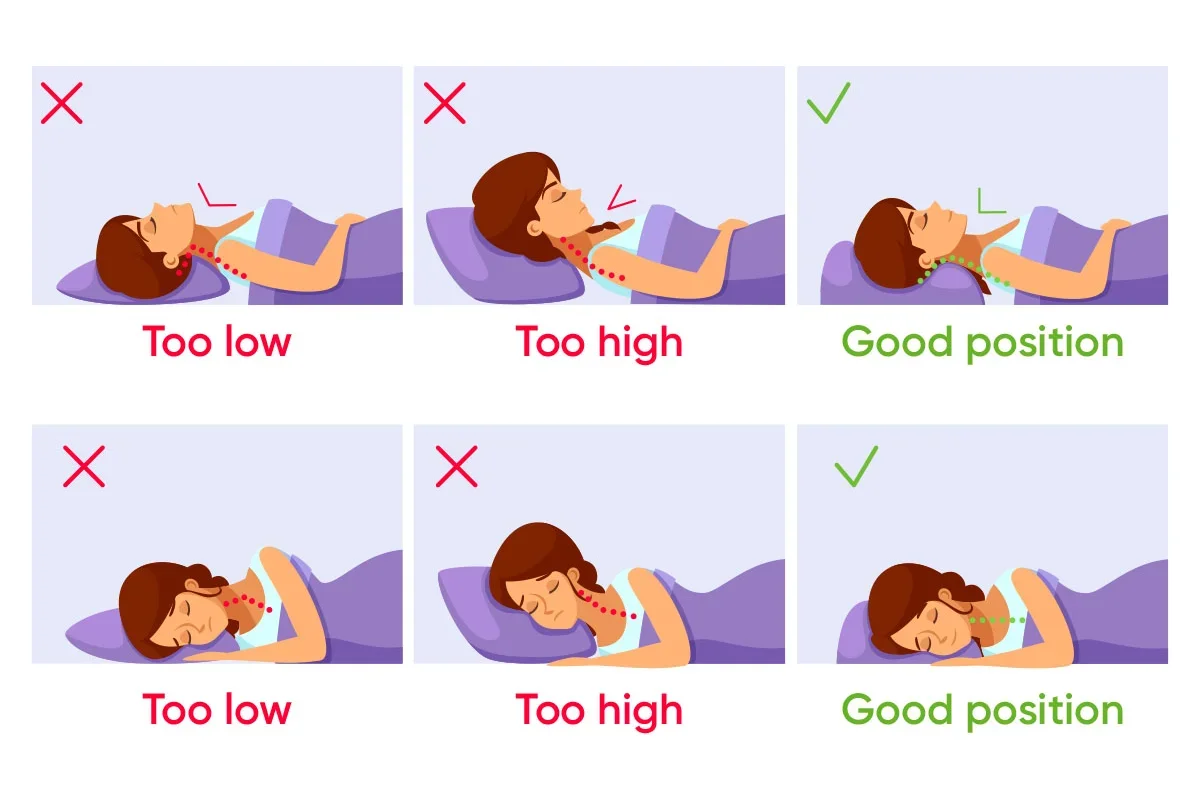Pillows - when two is too many and one is not enough!
Pillows are a regular topic of conversation with patients, as the perfect pillow seems to be quite elusive. With pillows, there’s definitely no one size fits all, as each person’s perfect pillow will be different. The thickness of your ideal pillow will be affected by the following factors;
Your sleeping position.
The shape and flexibility of your spine, especially your neck.
The width of your shoulders.
The softness of your mattress and your body weight.
Sleeping positions and pillow heights.
The key point with pillows is that they should keep your head, neck, and spine aligned in a straight line, no matter your sleeping position. This graphic shows what can happen to your neck if you are a side or back sleeper and your pillow is either too thick or too thin.
Every sleeping position changes how your spine and neck interact with the pillow. Below are some considerations about pillow height in relation to the three different sleeping positions.
Side Sleepers
Most people sleep on their side, and this position generally needs the thickest pillow to fill the gap between the shoulder and head.
Things to consider;
If you have broad shoulders, you will need a thicker pillow to keep your neck in alignment with your spine
If your mattress is soft, it will reduce the need for a thick pillow.
If you are heavy, you will sink into your mattress and it will reduce the need for a thicker pillow.
Back Sleepers
Back sleeping requires a medium-height pillow to maintain the natural cervical (neck) curve without pushing the head forward. Some people use a pillow with a gentle contour or dip that supports the neck’s hollow.
Things to consider;
If you have a relatively straight neck (a reduced cervical lordosis) you will need a thinner pillow.
If your mattress is soft, it will reduce the need for a thicker pillow.
If you are heavy, you will sink into your mattress and it will reduce the need for a thicker pillow.
Stomach (Prone) Sleepers
Sleeping on your front is the worst position for your neck. It forces the neck out of a neutral position into a twisted and backward position, and is more likely to irritate your neck joints and muscles. Generally, you should try to avoid sleeping on your front if you can, but if you can’t sleep any other way, then use a very soft, thin pillow (less than 6cm) or no pillow under the head at all. Like the other sleeping positions, if you have a soft mattress and/or are heavy, then you will sink into the mattress more and potentially put your neck in an even more compromised position.
So how DO you find the perfect pillow?
As discussed above, the perfect pillow will depend on a lot of different factors that will be unique to you. This means that randomly buying a pillow and hoping for the best is probably not going to work for most people. With this in mind, my two favorite pillows are ones that allow you to alter the height of the pillow by putting in or taking out material. This way, you can experiment with slightly different pillow heights to find the best one for you.
The two types of pillow I like are adjustable shredded memory foam pillows and adjustable wool-filled pillows
Shredded Memory Foam Pillows
These pillows are relatively inexpensive, and can be purchased on amazon for under £50 for two, for instance these ones. They come with a zip and a sealed inner compartment where you can remove or add the shredded memory foam to change the thickness of the pillow. This is a short video showing how it’s done. Studies highlight that shredded memory foam pillows can reduce morning neck stiffness compared to solid foam, give more balanced support, and allow better airflow.
2. Adjustable Wool Pillows
For those that prefer a pillow that is made of more natural materials, there are pillows that come with wool sheets or stuffing that can be added and removed to adjust the pillow thickness just like the memory foam versions. These are a bit more expensive than the memory foam versions and tend to be a little bit firmer.
This company makes pillows with wool stuffing and sells extra bags of wool which you can add to the pillow. This British company makes pillows that contain removable wool sheets which can also be purchased separately to change the height of the pillow.
Fine Tuning Your Pillow Thickness
If you decide to try these adjustable pillows, then you will obviously need to experiment with finding the ideal thickness. To start with, you can use your existing pillow as a rough guide to how thick the new one should be. You then need to sleep on the pillow for a night or two to get a sense of whether it needs to be increased or decreased in height. Depending on what you find, you will then need to add or remove material from the pillow accordingly. If you are using the shredded memory foam or wool , the pillow will need to be evened out after any changes. The wool sheet pillows are easier to adjust, as you just put in or take out a whole sheet.
What you end up with will depend on the individual factors I mentioned earlier. Ideally, you will want a ‘1 pillow solution’, as it’s easier to keep in place when you sleep. However, you could end up using 2 pillows with one being thick and the other very thin. A few years ago the perfect set up for me was 1 thick pillow with a thin folded towel underneath it!
Happy pillowing!
Cliff Russell, Registered Osteopath



